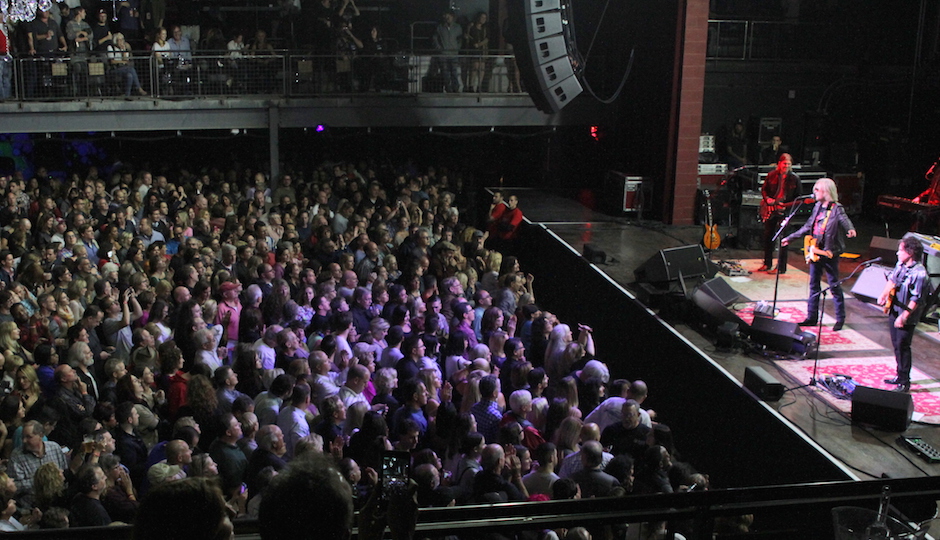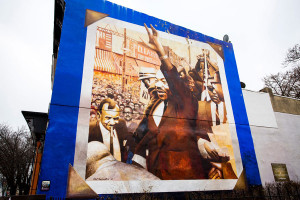The New Philadelphia Fillmore: Reviewed

Photo by HughE Dillon
Say this for Hall & Oates—they are nothing if not punctual. Last night’s curtain-raising show at the new Fillmore Philadelphia was set to start at 8pm, and I was still exploring the new venue when Michael Nutter introduced the hometown duo on stage. But no one in the sold-out crowd was there for the mayor, and really, the night felt more like a grand opening featuring a special musical guest than a Hall & Oates concert. The music was what you’d expect from two guys in the Rock & Roll Hall of Fame, who both gave requisite props to their hometown. But the star of the show was the Fillmore itself.
The big question was how would this converted World War II munitions factory stack up as a music venue? The answer is mostly positive. Aesthetically, it’s a sharp use of industrial space; by comparison, the similarly cavernous Electric Factory is like a makeover “before” photo. In the main hall, four crystal chandeliers hang from the ceiling, sparkling in the stage lights, and bars scattered everywhere (downstairs, upstairs, in the lobby) have a sleek, modern look. Tucked away upstairs is The Foundry, a 450-capacity room for smaller acts, and the Circle Bar, a VIP lounge with leather couches and roped-off reserved seating. The massive “LIVE” statue in the entranceway is a bit cheesy, but served as a prime selfie-taking destination point. Sightlines were also excellent—no problems seeing the performers from the floor or the mezzanine. With two bars along either side of the stage, you can grab a drink without missing the action. (Still, it’s best to walk around to the back bars for quicker service. You’ll hear the music well enough and face much thinner crowds.)

Photo by HughE Dillon
My biggest complaint was the sound. For a venue this size—smaller than the Factory by at least 500 to 1,000 bodies—I’d expect the audio to be close to crystal clear. But between songs, at times it was tough to understand what Hall and Oates were saying. I don’t know if it’s the exposed beams in the ceiling, the inevitable cavernous acoustics of a converted factory, the audio mix or a combination of all three, but the band sounded muddier than I anticipated. And as someone who sees a lot of live music, I rarely have this issue, but the overall volume was surprisingly low. At times, mid-song, the din of conversations in the crowd competed with the music itself. I don’t want to leave a concert with tinnitus, but this show could have used some more juice. As for getting there, if you’re driving, be aware the Fillmore lot holds 500 cars and traffic on Frankford Avenue bottlenecks fast—might be better off parking at SugarHouse and taking a short walk over.

Photo by Frank Jacobs III
Oh, and Hall & Oates were there, too. The blue-eyed soul practitioners delivered a solid set that ticked off nearly every hit in their catalogue (no “One on One” or “Family Man,” but otherwise, all faves accounted for) and made note of their local roots (“It’s been a long time, but this is our musical home,” said Daryl Hall. Added John Oates: “Here in Fishtown—how about that? I used to be afraid to come here.”). With his black leather jacket and wearing his sunglasses at night, it’s hard to believe Daryl Hall is just a few days shy of his 69th birthday. Sure, he pulled back on a couple of high notes and let the crowd pitch in on a few lines of “Sara Smile,” but credit him and John Oates for sounding better than most acts with their mileage.

Photo by Frank Jacobs III
The audience had a decidedly chilled-out VIP vibe, with a smattering of Philly bold-faced names (Eagles tight end Brent Celek; Sean Agnew of R5 Productions; Film Office chief Sharon Pinkenson; WMMR’s Matt Cord and Marisa Magnatta) and lots of folks wearing lanyards, seemingly more interested in looking cool than cutting loose (it was clearly not a millennial must-see show). But by the encores of “You Make My Dreams” and “Private Eyes,” nearly everyone was shimmying and hand-clapping.


